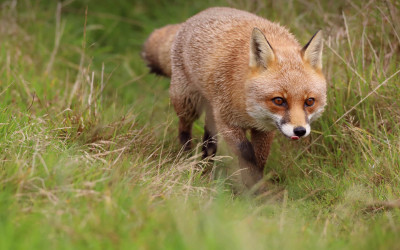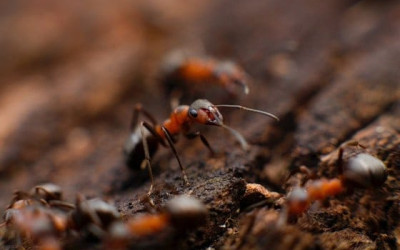MEET THE INVADERS
Yellow Crazy Ants
Tactical, territorial and terrifyingly good at invasion. That’s yellow crazy ants.
About 4 mm long, they are easily recognised by their yellow-brown colour and long legs and antennae. They aren’t picky eaters! They eat nectar, honeydew and fruit but also invertebrates like worms and insects, as well as small vertebrates like frogs, baby birds and lizards.
They thrive in tropical environments and can be found in bushland, along waterways, in urban areas and crop. Possibly native to Southeast Asia, these fierce invaders are among the world’s most successful invasive ants due to their adaptability, high reproductive rates and aggressive swarming behaviour. They swarm, sometimes in the tens of thousands, and use formic acid spray to subdue their prey and defend territory.
They have colonies with multiple queens that enhance their ability to establish and expand rapidly, forming sprawling supercolonies made up of multiple nests. They quickly expand their territory – sometimes advancing by a metre a day.
On Christmas Island, one such supercolony stretched across 750 hectares!
Worker ants have a life cycle of 76–84 days but queens survive for several years. They can reproduce at any time in the year but generally 1-2 months prior to the rainy season.
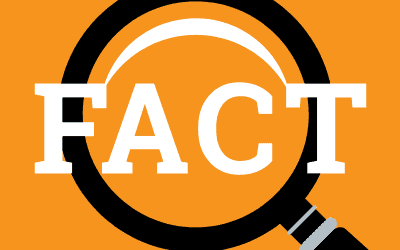
Yellow crazy ants get their name from their frantic, unpredictable movements when disturbed, making them appear ‘crazy’.
Invasion story
Yellow crazy ants were first discovered on Christmas Island sometime between 1915 and 1934.
By 1980, they were reported on the mainland at north-east Arnhem Land in the Northern Territory and in 2001 in the Wet Tropics of Queensland.
It is likely they were accidentally introduced to Australia via trade, particularly through shipments of timber and soil.
Between 2001 and 2010, at least 28 infestations were reported from Brisbane to Cairns.
In 2013 the Wet Tropics Management Authority established the Yellow Crazy Ant Eradication Program to protect the Wet Tropics World Heritage Area near Cairns.
The Cairns infestation in particular exploded. By 2022 more than 800 hectares, including rainforest, farms and residential areas had been taken over.
Following public outcry and significant government investment, by 2024 nearly 500 hectares (over half) of the Cairnes outbreak had been eradicated.
On Christmas Island, heavy infestations in inaccessible areas required continual expensive treatments to protect local wildlife – including the Christmas Island red crab. Recently, a biocontrol was introduced to the island – a micro wasp – which helps prevent yellow crazy ants from forming super colonies. This will help but full yellow crazy ant eradication on Christmas Island is unlikely.
A colony was also found in 2018 in Lismore, New South Wales but was, eradicated.
Over in the Northern Territory, 26 locations covering more than 295 hectares have been declared yellow crazy ant-free.
If left unchecked, climate modelling shows they could march right across Northern Australia, spreading from Queensland to Western Australia. They could even reach coastal and inland New South Wales.
How did we get here?
In 2011 yellow crazy ants gained widespread attention when a cane farmer in Edmonton, whose property bordered the World Heritage Area, found his patio swarming with ants and his dogs suffered temporary blindness and scarring.
By February 2012, Biosecurity Queensland had allocated $660,000 to combat infestations across the state, aiming for eradication. Yet by the end of 2012, they stopped treatments, deciding eradication was no longer feasible. This was because the Queensland government thought the ants had spread to too many locations. The responsibility then fell onto local community groups and councils. At the time, the infestation around Cairns was estimated at about 300 hectares.
The Wet Tropics Management Authority (WTMA) stepped up when the ants started to overwhelm the world heritage rainforest, particularly at Kuranda. But by the time the WTMA managed to get some federal funding in late 2013, it had spread to 570 hectares.
In 2017, the Invasive Species Council was working with the local council and community in Nome, south of Townsville, as a yellow crazy ants outbreak threatened a bird sanctuary and wetlands, including Bowling Bay Green National Park.
That grassroots effort laid the foundations for our ongoing advocacy for a fully fledged, federally funded, council-run eradication campaign in Townsville.
The toll on nature
Yellow crazy ants are listed as one of 100 of the world’s worst invasive alien species by the International Union for Conservation of Nature.
They don’t just take over – they destroy. In fact, they’re considered ‘ecosystem engineers’ because of the massive scale domino effect of their destruction, causing entire ecosystems to collapse. They’re a severe threat to people and pets too!
Yellow crazy ants swarm in large numbers and use their acid spray to kill much larger animals like lizards, frogs, small mammals, turtle hatchlings and bird chicks. When their numbers hit super colony levels, they’ve been known to leave entire forests silent.
Christmas Island is notorious for having suffered one of the worst infestations, reaching extraordinary densities, as high as 20 million per hectare. Here they have killed over 20 million red land crabs, which were crucial for the health of the island’s forest floor.
They do this by swarming over the crabs, spraying their acid onto the crabs’ eyestalks and leg joints, blinding and immobilising their death.
Yellow crazy ants also protect sap-sucking pests like scale insects that are killing our native plants because they feed on the sugary substances those pests produce, like honeydew. The huge increase in sapsucking bugs supports the growth of sooty moulds that severely damage plants, further degrading the forests of Christmas Island.
The yellow crazy ant invasion in the Queensland Wet Tropics World Heritage Area, could have been disastrous. Home to a staggering variety of wildlife, with 58% of Australia’s butterfly species, 40% of its birds, 36% of its mammals, 25% of its frogs and over 20% of reptile species12 and regarded as one of the most irreplaceable sites on earth.
That’s what’s at stake.
The Kuranda tree frog, for example, is found only in a very small area west of Cairns in north-east Queensland. It’s already battling several threats like chytrid fungus but are now being attacked by yellow crazy ants, pushing them closer to the brink of extinction.
Overseas, where yellow crazy ant colonies have formed near seabird colonies, they have killed and deformed large numbers of chicks by constantly spraying them with acid.
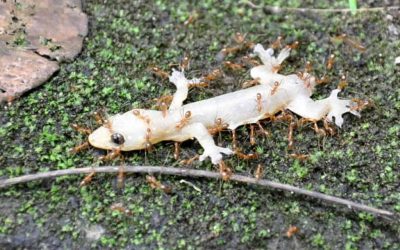
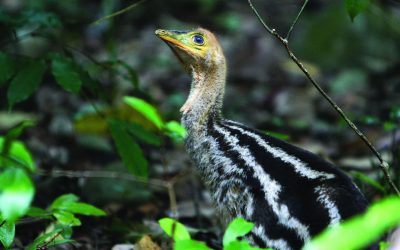
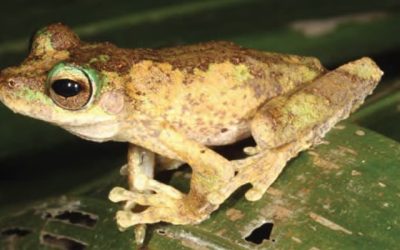
How do we fix this?
Australia has a small window of opportunity to keep the Wet Tropics safe from yellow crazy ants.
But the good news is, eradication is possible.
The work achieved in reducing the density of yellow crazy ants in Cairns promises to be one of the world’s most successful invasive ant eradication efforts.
But even eradication successes can be undermined by new invasions. Rigorous prevention from our biosecurity system is a must if we are to win.
To continue this fight against yellow crazy ants, it requires a coordinated, well-funded approach, including:
- Surveillance to detect and contain infestations early.
- Community engagement to report sightings and assist in monitoring.
- Sustained baiting programs using ant-specific insecticides.
- Innovative research into biological control methods to develop long-term solutions.
The Invasive Species Council is actively collaborating with government agencies, Indigenous groups and local communities to promote innovative management strategies and raise public awareness about the threat posed by yellow crazy ants.
FAQs
Their ability to form supercolonies and their aggressive behaviour, threaten small and endangered species, put humans and pets at risk and cause serious economic losses.
They prey on small animals, displace native ant species and indirectly harm our wildlife and environment by protecting insects that damage plants.
Control programs, including baiting and surveillance, are in place, but consistent funding and community involvement are essential for success.
If you come into contact with yellow crazy ants, quickly wash the affected area with water and soap to remove formic acid. If irritation persists or if you have an allergic reaction, seek medical attention. These ants are territorial and aggressive. If you’re near a nest or disturbed a colony, move away to avoid attracting more ants.
Lach, L., & Hoskin, C. (2024). Too Much to Lose: Yellow Crazy Ants in the Wet Tropics. Wildlife Australia.
Abbott, K. L., & Green, P. T. (2007). Collapse of an ant-scale mutualism in a rainforest on Christmas Island. Biological Invasions, 9(7), 887–897.
O’Dowd, D. J., Green, P. T., & Lake, P. S. (2003). Invasional ‘meltdown’ on an oceanic island. Ecology Letters, 6(9), 812–817.
Invasive Species Council. (2016). Yellow crazy ants in Australia: Retrieved from https://invasives.org.au/wp-content/uploads/2016/04/fs-yellow-crazy-ants.pdf
CSIRO, Yellow crazy ants, retrieved from https://www.csiro.au/en/research/animals/pests/yellow-crazy-ants.
Department of Climate Change, Energy, the Environment and Water. Crazy ant control options. Available at: https://www.dcceew.gov.au/sites/default/files/env/resources/898583db-b929-491a-8448-73fb652bca66/files/brochure-detail-crazy-ant-control-options.pdf
NSW Department of Primary Industries. (2021). Yellow crazy ants (Biosecurity & insect pests). https://www.dpi.nsw.gov.au/biosecurity/insect-pests/yellow-crazy-ant
Wet Tropics Management Authority 2025, ‘Action 1.3: Eradicate yellow crazy ants from the Wet Tropics of Queensland World Heritage Area’, Wet Tropics Management Authority, accessed 4 April 2025, https://www.wettropics.gov.au/action-13.
Wet Tropics Management Authority 2025, ‘What are yellow crazy ants?’, Wet Tropics Management Authority, accessed 4 April 2025, https://www.wettropics.gov.au/yellow-crazy-ants.
Queensland Department of Agriculture and Fisheries 2023, Yellow Crazy Ant, Queensland Government, accessed 4 April 2025, https://www.publications.qld.gov.au/ckan-publications-attachments-prod/resources/3d2b8556-dae2-4f96-9a8a-00a930485340/yellow-crazy-ant.pdf.
Bittel, J 2015, ‘The Christmas Crab Massacre’, Natural Resources Defense Council, accessed 4 April 2025, https://www.nrdc.org/stories/christmas-crab-massacre.
Lach, L., & Hoskin, C. (2024). Too Much to Lose: Yellow Crazy Ants in the Wet Tropics. Wildlife Australia.
Abbott, K. L., & Green, P. T. (2007). Collapse of an ant-scale mutualism in a rainforest on Christmas Island. Biological Invasions, 9(7), 887–897.
O’Dowd, D. J., Green, P. T., & Lake, P. S. (2003). Invasional ‘meltdown’ on an oceanic island. Ecology Letters, 6(9), 812–817.
Invasive Species Council. (2016). Yellow crazy ants in Australia: Retrieved from https://invasives.org.au/wp-content/uploads/2016/04/fs-yellow-crazy-ants.pdf
CSIRO, Yellow crazy ants, retrieved from https://www.csiro.au/en/research/animals/pests/yellow-crazy-ants.
Department of Climate Change, Energy, the Environment and Water. Crazy ant control options. Available at: https://www.dcceew.gov.au/sites/default/files/env/resources/898583db-b929-491a-8448-73fb652bca66/files/brochure-detail-crazy-ant-control-options.pdf
NSW Department of Primary Industries. (2021). Yellow crazy ants (Biosecurity & insect pests). https://www.dpi.nsw.gov.au/biosecurity/insect-pests/yellow-crazy-ant
Wet Tropics Management Authority 2025, ‘Action 1.3: Eradicate yellow crazy ants from the Wet Tropics of Queensland World Heritage Area’, Wet Tropics Management Authority, accessed 4 April 2025, https://www.wettropics.gov.au/action-13.
Wet Tropics Management Authority 2025, ‘What are yellow crazy ants?’, Wet Tropics Management Authority, accessed 4 April 2025, https://www.wettropics.gov.au/yellow-crazy-ants.
Queensland Department of Agriculture and Fisheries 2023, Yellow Crazy Ant, Queensland Government, accessed 4 April 2025, https://www.publications.qld.gov.au/ckan-publications-attachments-prod/resources/3d2b8556-dae2-4f96-9a8a-00a930485340/yellow-crazy-ant.pdf.
Bittel, J 2015, ‘The Christmas Crab Massacre’, Natural Resources Defense Council, accessed 4 April 2025, https://www.nrdc.org/stories/christmas-crab-massacre.






